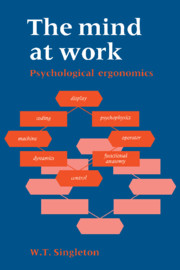3 - NEEDS AND ORGANISATIONS
Published online by Cambridge University Press: 22 September 2009
Summary
Concepts
Social factors
Activity involving others
It is rare for a human being to do anything in isolation for very long. It is possible to think of examples such as the tractor driver who may be alone for a working day, and there are unusual tasks such as single-handed yachting where the person may be alone for several weeks. Nevertheless, the obvious rarity of these illustrations emphasises the point that people at work are usually interacting with other people.
This may involve the interdependence of tasks, in which case there is a team or crew involved or it may be that people happen to be working in the same location and the interaction is social rather than operational. Many, perhaps most, tasks are of an intermediate kind where there is some common purpose linking the tasks, but nevertheless individuals are working more or less independently and their interaction is mainly social. They may chat at intervals, they share rest periods and meals and they may travel to and from work together. This is the common situation in industry and commerce. The social interaction is very highly prized, it is often mentioned as the main reason for enjoying going to work. A different kind of interaction occurs when one person is providing a service for a second person, for example the shop assistant or the dentist.
- Type
- Chapter
- Information
- The Mind at Work , pp. 135 - 158Publisher: Cambridge University PressPrint publication year: 1989



